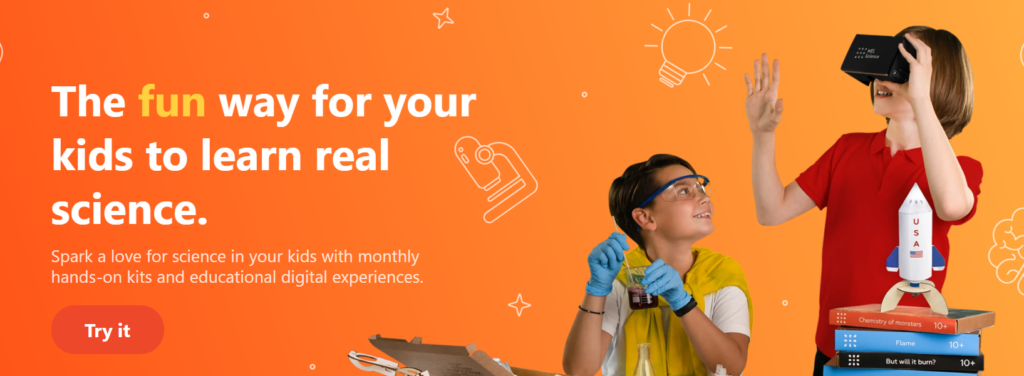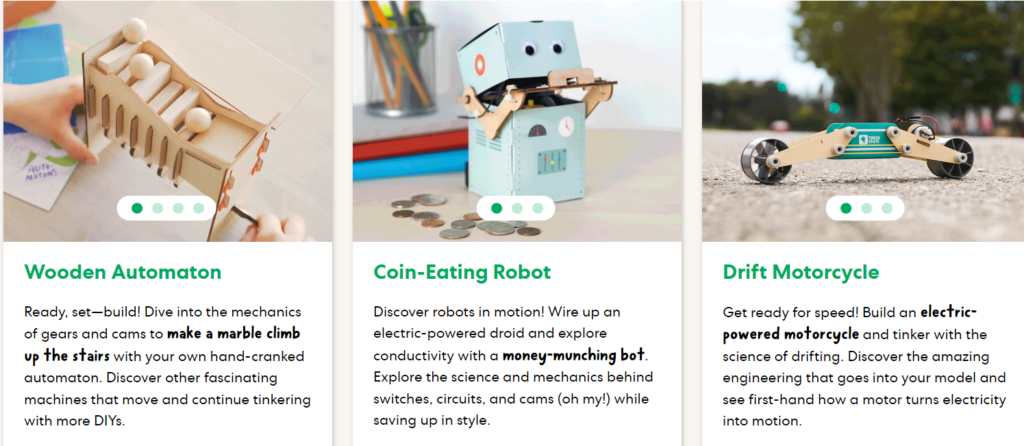Introduction
In a world increasingly shaped by science and technology, sparking an interest in STEM (Science, Technology, Engineering, and Mathematics) from an early age has become crucial. Hands-on learning is one of the most effective ways to engage children with complex scientific concepts, and this is where subscription-based science kits come into play. Two popular options in this realm are MEL Science and Tinker Crate by KiwiCo.
Both of these kits are designed to inspire curiosity and provide children with engaging, practical experiences in science and engineering. MEL Science focuses on chemistry, physics, and other core scientific fields, enhanced by cutting-edge virtual reality (VR) lessons.
Meanwhile, Tinker Crate leans towards engineering and mechanical exploration, offering DIY projects that teach principles of building and problem-solving. While both aim to make science fun, they differ significantly in their content, learning styles, and age focus.
In this detailed comparison, we will explore the differences between MEL Science and Tinker Crate, breaking down their features, pricing, and the type of learning experiences they provide. Whether you are raising a future engineer or a young scientist, this guide will help you choose the right kit to ignite your child’s passion for STEM learning.
Overview
MEL Science
MEL Science is a subscription-based service that offers advanced science experiments primarily aimed at children aged 9-14. Its focus is on creating a deeper understanding of chemistry, physics, and even VR-based interactive lessons. Founded with the mission to make science exciting and approachable, MEL Science provides not only the hands-on experiment kits but also offers additional educational content through VR lessons and interactive apps.

Tinker Crate by KiwiCo
Tinker Crate, a part of the broader KiwiCo family, is a monthly subscription box aimed at younger children aged 9-16. Tinker Crate emphasizes engineering and technology, allowing kids to build functional models like hydraulic arms, robots, and mechanical devices. KiwiCo, the parent company, offers a wide range of crates for different age groups and interests, with Tinker Crate being the option most focused on tinkering and scientific exploration.
Both services aim to encourage curiosity, foster creativity, and make learning enjoyable. However, they offer different kinds of learning experiences, which will be unpacked in this detailed comparison.

Features
MEL Science Features
- Advanced Science Experiments MEL Science kits provide complex experiments across multiple fields of science, including chemistry, physics, and biology. The kits offer an exciting mix of chemical reactions and scientific principles to explain key STEM concepts.
- Virtual Reality (VR) Lessons One of the unique selling points of MEL Science is its use of virtual reality. The subscription provides access to VR lessons, which allow children to explore various scientific phenomena in an interactive way. The VR lessons cover topics such as atomic structures, molecular bonding, and chemical reactions, offering an immersive learning experience.
- Detailed Instructional Support Each experiment in MEL Science is supported by detailed online instructions, live lessons, and even AR (Augmented Reality) models. This allows parents and children alike to fully grasp the scientific concepts behind the experiment.
- Science App MEL Science offers a companion app that helps guide the experiments, offers additional content, and integrates with the VR lessons. The app has been designed to offer age-appropriate content and allows kids to explore science more interactively.
- Wide Range of Topics The MEL Science experiments cover various scientific fields, including:
- Chemistry: chemical reactions, molecular bonding, elements
- Physics: electricity, magnetism, mechanics
- STEM projects: robotics, circuits, and more
- Hands-on Learning Every kit is designed to be hands-on, with real lab equipment provided to make the experiments feel authentic. The materials used are safe for home use, and children get to feel like real scientists.
Tinker Crate Features
- Engineering-Focused Projects Tinker Crate primarily focuses on engineering and physical sciences. Each box includes a DIY project that introduces engineering principles. The projects involve building things like robots, mechanical arms, hydraulic lifts, and other devices that illustrate important scientific concepts like gravity, force, and mechanics.
- Instructional Materials Tinker Crate includes step-by-step instructions in both printed form and online tutorials. The guides are illustrated, making them easy for children to follow. Additionally, each crate comes with a “Tinker Zine,” a booklet filled with fascinating articles, science trivia, and additional activities related to the theme of the crate.
- Hands-on Learning Like MEL Science, Tinker Crate is designed to be a hands-on learning experience. Every kit encourages kids to tinker with the materials, helping them to learn by doing. Whether it’s constructing a wind-powered vehicle or a hydraulic claw, the projects require kids to engage with the engineering design process.
- Broad Science Coverage While Tinker Crate is more focused on engineering, it does also cover various scientific disciplines. Some recent projects include:
- Building mechanical robots
- Creating circuit boards
- Exploring the science behind hydraulic systems
- STEM Learning The projects are designed to encourage STEM learning, with an emphasis on critical thinking and problem-solving. Kids are not just building models; they are learning why and how things work, and each project is paired with explanations that make the science behind the project clear.
- Tinker Zine Each crate comes with a Tinker Zine, a mini-magazine packed with additional learning content. This zine provides background on the project, fun facts, and extension activities for deeper learning.
Pricing
MEL Science Pricing
MEL Science operates on a subscription model with the following tiers:
- Monthly Subscription: $39.90 per month, which includes a science kit with two to three experiments.
- Annual Subscription: $399 per year, providing 12 monthly kits and a discount on the per-box price.
Additionally, the VR lessons and science app are included at no extra cost with each subscription. MEL Science also occasionally offers promotional discounts for new subscribers, making it a slightly more affordable option for families willing to commit to a long-term subscription.
Tinker Crate Pricing
Tinker Crate is also subscription-based and offers multiple pricing plans:
- Monthly Subscription: $23.95 per month for one crate.
- 3-Month Subscription: $67.95, which breaks down to $22.65 per month.
- 6-Month Subscription: $131.70, or $21.95 per month.
- 12-Month Subscription: $239.40, or $19.95 per month.
Tinker Crate offers a lower starting price compared to MEL Science, making it a more budget-friendly option for families, especially those looking for engineering-focused projects.
FAQ
MEL Science FAQ
What age group is MEL Science suitable for?
MEL Science is recommended for children aged 9-14, though younger or older children may also enjoy the experiments with adult supervision.
How safe are the experiments?
All MEL Science experiments are designed with safety in mind. The kits include safety goggles, gloves, and detailed instructions to ensure safe experimentation.
Can I cancel my subscription?
Yes, you can cancel your MEL Science subscription at any time through your account dashboard.
What’s included in a MEL Science kit?
Each kit includes all necessary lab equipment, chemicals, and materials to conduct two to three experiments. Access to VR lessons and the MEL Science app is also included.
Are there any additional learning resources?
Yes, MEL Science offers VR lessons, online instructions, and live sessions with science experts for additional learning support.

Tinker Crate FAQ
What age group is Tinker Crate suitable for?
Tinker Crate is designed for children aged 9-16, although it can be enjoyed by kids who are interested in building and creating things.
What types of projects can we expect?
Tinker Crate offers engineering-based projects that involve building things like robots, hydraulic systems, and other mechanical devices.
Can I pause or cancel my subscription?
Yes, Tinker Crate allows you to pause or cancel your subscription at any time without penalty.
What comes with each Tinker Crate?
Each crate contains all the materials needed for the monthly project, an instruction booklet, and a Tinker Zine with additional information and activities.
Is there any digital content?
Yes, Tinker Crate provides online tutorials and resources to help guide children through the projects.

Conclusion
Both MEL Science and Tinker Crate offer fantastic opportunities for children to engage with science in a fun and interactive way. However, the best choice for your family depends on your child’s interests and your budget.
In the debate between MEL Science and Tinker Crate, both options stand out as excellent tools for encouraging STEM learning in young minds. Each subscription service has its own unique strengths, making them suited for different learning styles and interests.
MEL Science shines with its focus on advanced scientific concepts like chemistry and physics, combined with the immersive experience of virtual reality lessons. It is ideal for children who are curious about the natural world, enjoy complex experiments, and want to explore science in depth. The inclusion of VR and AR technologies sets MEL Science apart as a more comprehensive learning experience, though it comes at a higher price point.
On the other hand, Tinker Crate excels in its hands-on, engineering-focused approach. It allows kids to build and tinker with projects that teach key principles of mechanics, robotics, and problem-solving. The affordability of Tinker Crate, along with its fun, interactive projects, makes it a great choice for young inventors and builders who love to explore how things work.
In essence, the decision between MEL Science and Tinker Crate boils down to your child’s specific interests. If your child leans toward scientific exploration and enjoys working with chemistry or physics, MEL Science will be the better fit. If your child loves engineering and building things, Tinker Crate offers excellent value and learning through creative projects.
Regardless of which kit you choose, both will provide a valuable educational experience that goes beyond the classroom, fostering creativity, critical thinking, and a lifelong love of learning in STEM.



